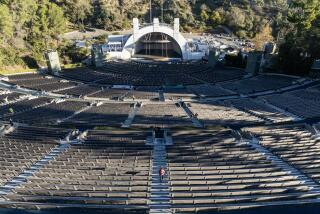Holiday Bowl: Strike or Spare?
- Share via
For four decades, the Holiday Bowl has served a comparable purpose--cultural, architectural, recreational--for the Crenshaw district as the Hollywood Bowl has for the Hollywood Hills. Designed by the firm of Armet & Davis, who defined ‘50s Googie architecture, the Bowl was built by Japanese entrepreneurs as a combination bowling alley, pool hall, bar and coffee shop in 1958 to serve Crenshaw’s Japanese enclave, which had not long before suffered Manzanar’s internment camps and a blanket racial ban by the American Bowling Congress. Once haunted at 4 a.m. by swing-shift aerospace workers and nighthawk Central Avenue jazz musicians, the Holiday Bowl, like Leimert Park to its south, remains a concrete expression of community in an era when the whole notion of community has been raised to the level of abstraction.
But a recent “For Sale” sign on the shuttered Majestic Pontiac dealership next door threatens to make the Bowl, too, an abstraction. “This is our corner for 40 years, and they’d like to put this down,” says 70-year-old coffee shop customer Rex Sullivan. “What they’re doing is knocking down the community.” The property’s owner, Marshall Siskin of Siskin Investments, declines to comment, but a real estate broker has listed the entire city block, including the site of the Bowl, for $10 million.
The Bowl’s proprietor dispels rumors of its demise, including the broker’s claim that his lease is month-to-month. “We have a lease of 14 years, and there are still 12 years left,” Duke Kim says. When such rumors are spread, “that’s the best way for a landlord to ruin a business. They create the problem. They ruin the tenant and kill the tenant.”
This sultry afternoon, in the coffee shop, with its crazy zigzag roof and floor-to-ceiling windows, or in the cool recesses of its Sakiba (guttural for sake bar), or on the lanes where octogenarian bowlers shamble up beside neighborhood children, the Bowl’s usual calm prevails. “Tell them to do something with the air conditioning,” gripes 69-year-old Eunice Hahn, who, with her friend Michi Tanji, 55, has arrived for a regular match of the Nisei housewives bowling league.
For Gail Dubrow, an associate professor of architecture and urban design at the University of Washington, the Bowl is a rare post-Manzanar cultural landmark. “The internment camps have historic designation,” says Dubrow, co-author of an upcoming book on West Coast Japanese American heritage that includes a chapter on the Holiday Bowl. “It’s like our sense of history ends with internment, and people have no mental picture of what it meant to come back.”
As a commercial architect, 82-year-old Eldon Davis realizes that he has not been in the business of building cultural monuments. But Armet & Davis Job No. 257, he says, might be an exception. “If this bowling alley would be permanent, that would be OK with me. We think of churches and other community buildings, but, heck, bowling alleys are community buildings. It’s working out that way here. So why not?”
More to Read
The biggest entertainment stories
Get our big stories about Hollywood, film, television, music, arts, culture and more right in your inbox as soon as they publish.
You may occasionally receive promotional content from the Los Angeles Times.










